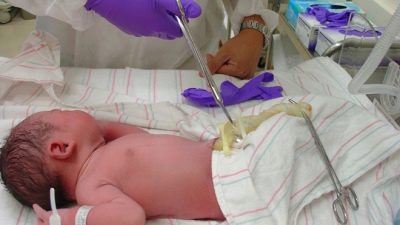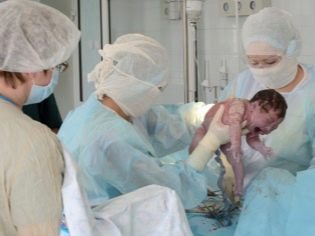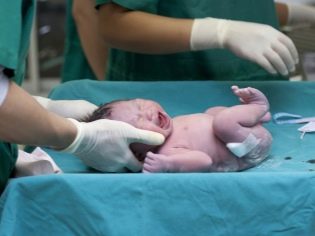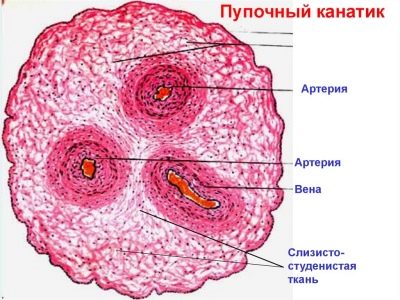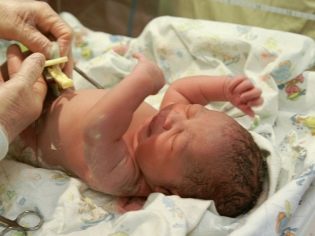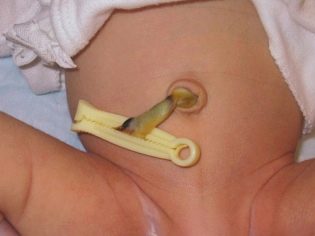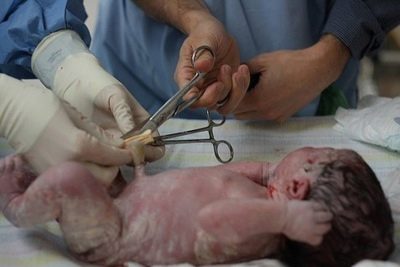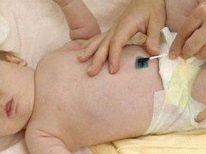Cutting, bandaging or clamping the umbilical cord after delivery
The birth of a child cannot be imagined without cutting the umbilical cord - such a procedure in maternity hospitals is carried out to each newborn baby. This article will tell you more about cutting, bandaging and clamping the umbilical cord after delivery.
Why is this done?
The umbilical cord (umbilical cord) is a very important organ that appears in the female body only during pregnancy. It is vital, as it is a kind of bridge between the mother and her baby.
Through the umbilical cord, the baby growing in the womb feeds and receives oxygen. During his prenatal life, the child is not able to eat independently. All nutrients enter his body through the blood vessels that are in the umbilical cord. Proteins, fats and carbohydrates, necessary for proper growth, the baby receives through the blood from his mother.
This biological connection between the child and his mother persists throughout the pregnancy. It stops only after giving birth, when the baby is born.
It is impossible to imagine the full development of a child without a umbilical cord. This organ is directly involved in the intrauterine life of the fetus - thanks to the nutrients and oxygen entering the children's body, the development of internal organs and systems occurs in the fetus.
The moment when the doctors cut the umbilical cord can be considered as the cessation of intrauterine development and the beginning of a new life for the baby.
Cutting
Since ancient times, cutting the umbilical cord has been considered a real sacrament. It was believed that at this time the child can be charged with the positive energy that he will need throughout his life. For many centuries, it was considered a good sign if a cordial person would cut the umbilical cord. People considered this a real sign, which marked a beautiful and peaceful life for a newborn baby.
Now everything has changed. Childbirth takes place in special delivery rooms, where sterility is observed.
The umbilical cord is most often cut by a doctor, using pre-treated medical instruments. This management of labor contributes to the fact that the number of cases of birth infection that can develop during the cutting of the umbilical cord, has decreased significantly. Competent obstetric aid is an important pledge for the birth of a healthy baby.
You can cut the umbilical cord within a certain time after the birth of the baby. The anatomical structure of the umbilical cord contributes to the fact that after the baby is born, the umbilical cord begins to atrophy independently. After the baby is born, the umbilical cord is an unnecessary organ, and therefore its atrophy begins.
The time of cutting the umbilical cord is always determined only by doctors. It was the doctors who chose the right moment for this important procedure. However, times are changing, and today there are quite a few private medical clinics, in which parents decide how many minutes after the baby is born. Certainly, at this moment, the doctors who control the development of the situation are next to the woman who is giving birth.
The biomechanism of childbirth involves first the birth of a baby, and then the afterbirth and the umbilical cord are born. Inside the umbilical cord are blood vessels. This contributes to the fact that after the birth of the child into the world the umbilical cord pulses a little more. This situation is absolutely normal.
It is important to understand that as soon as the doctor presses the umbilical cord with special clips or clamps, the child immediately stops the blood supply to the internal organs at the expense of the mother. From this point on, the baby’s cardiovascular system begins to function independently.
Also, after cutting the umbilical cord, the child stops receiving hemoglobin-rich blood from his mother.
Does the newborn hurt?
Childbirth is a very strong stress not only for the mother, but also for her baby. Many women believe that the baby does not feel anything, but this is not entirely true. Passing a child through the birth canal and changing habitat is a very strong stress. A newborn baby does not yet know how to speak, but usually expresses its emotions by crying. Women who have already become mothers know that after their first breath, the baby begins to cry a lot.
However, it should be noted that the birth of a baby is to a greater extent psychological stress. On the physical level, the child does not experience severe pain if the birth was successful. If the newborn baby developed a strong pain syndrome, then obstetrician-gynecologists would be forced to give him an anesthetic injection, but they do not.
Nature has carefully envisioned several features, why the child does not have pain when cutting the umbilical cord. So, in the umbilical cord there are no nerve endings. Also, when a child after his birth lies on the mother's breast, quite a lot of hormones of joy are produced in his body - endorphins. It also contributes to the fact that the baby calmly transfers cutting the umbilical cord.
For a long time, the doctors did not put the newborn child on the breast to the mother, and only due to a number of scientific studies did the postpartum tactic change. Scientists believe that when a baby is placed on the mother’s breast immediately after birth, the baby begins to breathe better independently, which means an independent life in a new habitat.
How to cut the umbilical cord?
For a long time in obstetric practice it was believed that the umbilical cord can only be tied up with a specialist and immediately after the birth of the child. Modern studies have shown that it is not worth rushing to immediately cut the umbilical cord when the baby is born.
Postpartum tactics depend on the clinic and even the country in which the baby is born. So, many obstetrician-gynecologists after birth of a child immediately put it on the breast of the mother, but do not rush to quickly cut the umbilical cord. For some time, while the pulsation of the umbilical vessels remains, the baby remains connected to the mother through the umbilical cord. Such a postpartum tactic, according to some doctors, contributes to the fact that the baby receives oxygen through spontaneous breathing, as well as some additional time in the umbilical cord of the umbilical cord.
Also, this tactic contributes to the fact that the child has a much lower risk of lowering the level of hemoglobin in the blood. This is due to the flow of blood through the umbilical vessels within a few minutes. Many experts believe that such postpartum tactics is more favorable and even comfortable for the baby. They believe that in this way the baby is much easier to tolerate a change in habitat.
In most cases, in the maternity hospitals, the umbilical cord is still cut by the doctor, not the father of the baby. This procedure is carried out only with the use of sterile tools. Before cutting the umbilical cord, the doctor places special clip-on clips on the umbilical cord.This is necessary to stop the flow of the umbilical vessels.
Pre-compression of the umbilical cord clamps is also necessary so that after delivery a woman does not develop severe bleeding. This procedure is very important. After the umbilical cord is cut, the terminals on the umbilical cord remain for some time. It is also necessary so that the woman in labor will not have complications, including heavy bleeding.
The clamping time of the umbilical cord depends on many factors. So, for women who have diseases of the blood coagulation system, the time period may be longer. The exact time of preservation of clips on the umbilical cord in this case is determined by the obstetrician, who leads a specific birth.
Is it possible immediately after the birth of the baby to cut the umbilical cord?
The time during which the umbilical cord should be cut by a newborn is always a reason for medical discussions. For many years, doctors believed that this should be done within 30-60 seconds after the baby was born. However, further research was conducted, which resulted in a truly shocking data.
So, scientists believe that rushing to cut the umbilical cord that binds mother and baby is not worth it. Such a delayed cutting of the umbilical cord, in their opinion, will be more favorable for both the baby and his mother.
It must be said that many American doctors perform the procedure for cutting the umbilical cord in this way. They are not in a hurry to immediately break the link between the maternal and the child's body, which existed together during all the months of pregnancy. Moreover, in most American clinics, cutting the umbilical cord is performed by the father of the baby, who is with his wife during the birth of the long-awaited baby.
Co-birth in the United States is a fairly common practice. Before the umbilical cord is cut off, the doctors talk to the future father. They explain to him what time to cut and how to do it technically. It should be noted that before the visit, the future father gave birth to a small examination. This is important because there is a fairly high risk of infection during labor.
It is very important that all those present at the time of the birth of the child did not have contagious or even catarrhal diseases.
It should be noted that not all doctors use this practice of delayed cutting of the umbilical cord. In many leading European clinics, obstetrician-gynecologists still use tactics when the umbilical cord is cut off within a couple of minutes from the moment the child was born. Doctors who choose this method of delivery, believe that in this case, the risk of infecting the baby with various infections is significantly lower.
Currently, doctors have not come to a common opinion about when to cut the umbilical cord. Each country in the world has its own standards of management of labor, which provide for the choice of specific tactics of obstetrics. More loyal in this matter are private clinics. In many of them, parents, even at the planning stage of labor, can discuss with their doctors the desired time when the umbilical cord will be cut off. Also during such a conversation, the doctor asks the future father whether he will attend childbirth and whether he wants to cut the umbilical cord.
Is it possible not to cut the umbilical cord at all?
Many parents are interested in the question of what will happen if the baby does not cut the umbilical cord, and whether it falls off after the birth itself.
Indeed, the umbilical cord after the birth of a child can simply dry out, if it is squeezed after the baby is born. Usually such a situation is possible if parents for some reason decide to carry out home birth.
Immediately, we note that this practice is not supported by most medical practitioners. Doctors believe that cutting the umbilical cord is worth it.This should be done for a maximum of 20-30 minutes after the birth of the child. In such a situation, the risk of developing dangerous complications, including infection of mother and baby with dangerous infections, is minimal.
When is it necessary to cut off urgently?
It should be noted that in obstetric practice there are certain clinical situations in which it is impossible to delay the cutting of the umbilical cord. One of them is considered Rh-conflict - in this case, the mother and child have different Rh factors. Rhesus conflict is a dangerous pathology that can contribute to the development of terrible complications. In order to prevent their occurrence, doctors during labor with the cutting of the umbilical cord, as a rule, do not hesitate.
Aftercare
After the baby is born, a stump of a cut umbilical cord needs special care. This is necessary in order to reduce the risk of infection. The stump of the cut umbilical cord - the wound surface. It takes several days to heal, during which time this area should be properly cared for.
Doctors still in the maternity hospital teach the mother of a newborn baby how to properly handle the navel of a baby. Recommendations are also made at the outpatient stage, when a woman with her child is already being discharged from the hospital home.
On average, it takes several weeks or even a month to heal an umbilical wound. Mom should carefully monitor the condition of the wound surface in a newborn.
For information on cutting, bandaging or clamping the umbilical cord after delivery, see the next video.


